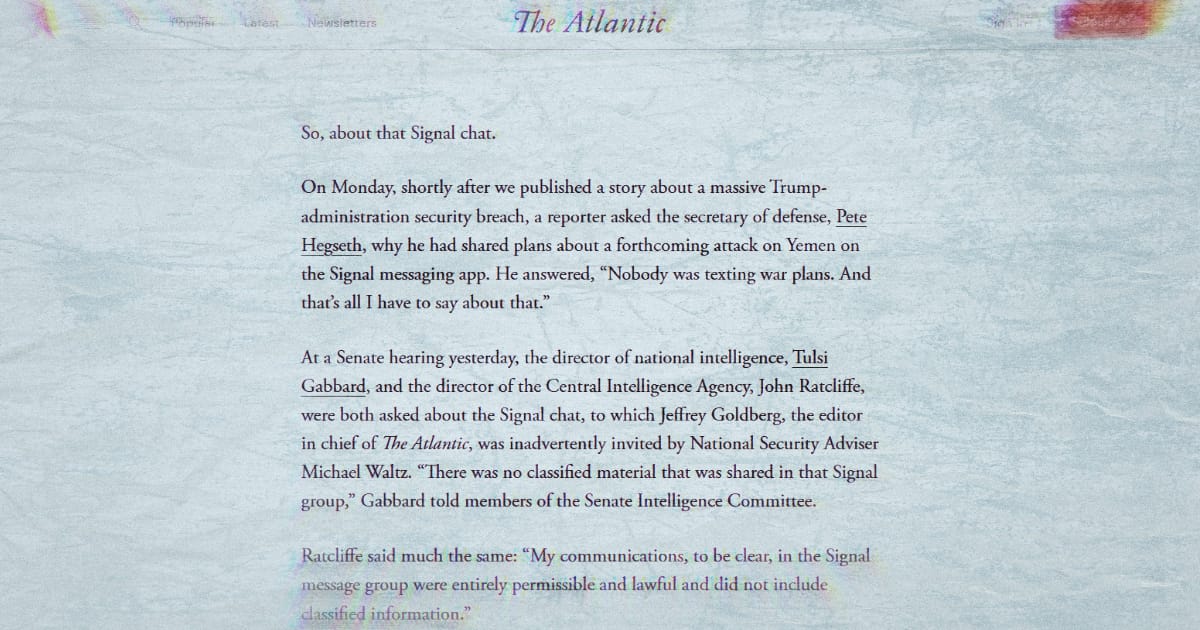
Trump Yemen War Plans Leak: 5 Explosive Messages The White House Denies
Jump to:
The Atlantic vs. Trump: A Dangerous Leak
The Trump Yemen war plans leak took a startling turn this week after The Atlantic published a series of Signal messages that show senior officials sharing explicit military strike details in a supposedly secure group chat—one that accidentally included journalist Jeffrey Goldberg. Despite repeated denials from former President Trump and top aides, the texts reveal that Defense Secretary Pete Hegseth disclosed attack timing, aircraft, and weapons used in the U.S. airstrike on Houthi targets in Yemen.
How The Atlantic Got the Signal Chat
The saga began on March 13 when National Security Advisor Michael Waltz mistakenly added The Atlantic’s editor in chief Jeffrey Goldberg to a Signal group chat dubbed “Houthi PC small group.” The chat included Hegseth, Waltz, FBI Director John Ratcliffe, and Director of National Intelligence Tulsi Gabbard. Over two days, Goldberg received messages detailing sensitive military operations, including specific targeting information before a surprise strike on March 15.
Goldberg removed himself from the chat after realizing what he was seeing. On March 24, he and staff writer Shane Harris published an initial report about the incident—choosing to withhold operational specifics to avoid compromising U.S. personnel.
Trump’s Denials and Hegseth’s Evasion
In the aftermath, Trump dismissed the story, claiming the group chat was “very boring” and “not classified.” Pete Hegseth flatly denied any wrongdoing, telling reporters, “Nobody was texting war plans.” Trump further lambasted The Atlantic as “a failed magazine,” accusing them of fabricating the story entirely. He also publicly praised Waltz, the man who added Goldberg to the group, calling him “a very good man.”

The Texts That Change Everything
On March 26, The Atlantic released the actual Signal transcripts in full, citing overwhelming public interest. The texts show Hegseth, on March 15 at 11:44 a.m. ET, sending a message with exact timing for the upcoming strike—just 31 minutes before U.S. warplanes were deployed. Two hours later, a specific Houthi figure referred to as “Target Terrorist” was scheduled for elimination.
“Launching birds in 31. Reaper w/Hellfires inbound on sector Zulu. Primary will be in the red at 1345Z. Stack up for contingencies.” — Pete Hegseth via Signal, March 15, 11:44 a.m. ET
That text was received not only by fellow U.S. officials but also by Goldberg, who was still in the chat at the time. If the message had reached someone less ethical—or simply indiscreet—the results could have compromised the entire operation and endangered U.S. personnel.
Why This Leak Matters: Timing, Targets, and Risk
Goldberg and Harris note the gravity of what was shared: “Had these details reached a hostile actor, the Houthis would have had enough time to reposition assets, conceal leadership, or even launch countermeasures.” In the national security world, 31 minutes is an eternity.
Trump’s assertion that “nothing classified” was shared relies on a narrow—and arguably reckless—interpretation of what constitutes a security breach. Whether or not the information was formally marked as “classified,” the texts disclosed operational plans in real time over an unsecured app to an unintended recipient. That fact alone would normally trigger an internal investigation under any other administration.
How Did This Happen? The Trump Team’s Carelessness
The incident underscores a broader issue: a culture of carelessness surrounding national security during the Trump administration. From Trump sharing classified Israeli intelligence with Russian diplomats in 2017 to storing sensitive documents at Mar-a-Lago, there’s a clear pattern of treating classified materials—and national security—as afterthoughts.
The latest incident involving the Trump Yemen war plans leak is even more glaring given the chain of command involved. Michael Waltz, a former Green Beret turned National Security Advisor, added a journalist to a group chat discussing real-time military strikes. Pete Hegseth, a Fox News personality turned Defense Secretary, casually texted about imminent kill orders. Tulsi Gabbard, a controversial choice for DNI, said nothing—nor did Ratcliffe, who had access to the full intelligence pipeline.
None of these individuals, according to The Atlantic, flagged the error or raised concerns over the course of three days. It was Goldberg who chose to remove himself from the chat. The officials, it seems, never noticed he was there.
Central to the controversy is an internal Pentagon security directive issued March 18, explicitly instructing all officials to immediately cease using Signal due to vulnerabilities actively exploited by Russian-linked cyber espionage groups. Despite this clear directive, Defense Secretary Pete Hegseth, National Security Advisor Mike Waltz, Vice President J.D. Vance, and other senior officials continued utilizing the compromised platform.
Conclusion: A War Plan, a Journalist, and a National Security Disaster
The Trump Yemen war plans leak isn’t just about sloppy tech hygiene or petty political denialism—it’s about a breach of basic military protocol that could have cost lives. The Atlantic’s publication of the Signal texts provides definitive evidence that senior officials in the Trump administration shared mission-critical strike details over a nonsecure channel. Worse, they did so without realizing they had accidentally looped in a member of the press.
In any functioning democracy, such a leak would prompt a congressional hearing and likely a Department of Defense review. At minimum, it should disqualify several individuals from ever holding national security positions again. Instead, the Trump team is betting that denial, distraction, and disdain for journalism will once again carry the day.
But this time, the receipts are public. And America is watching.
What are your thoughts on this issue? Join the conversation below.



